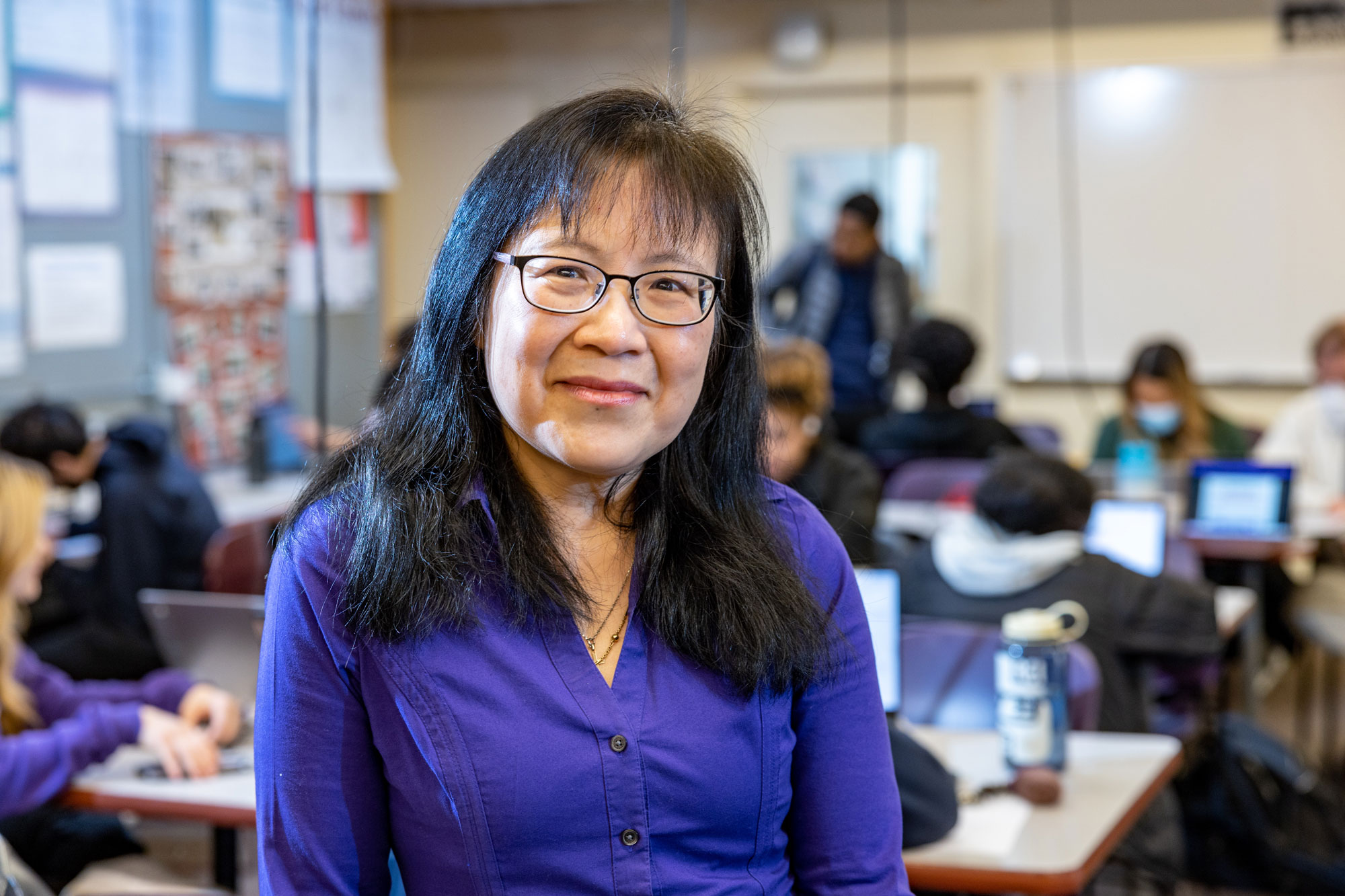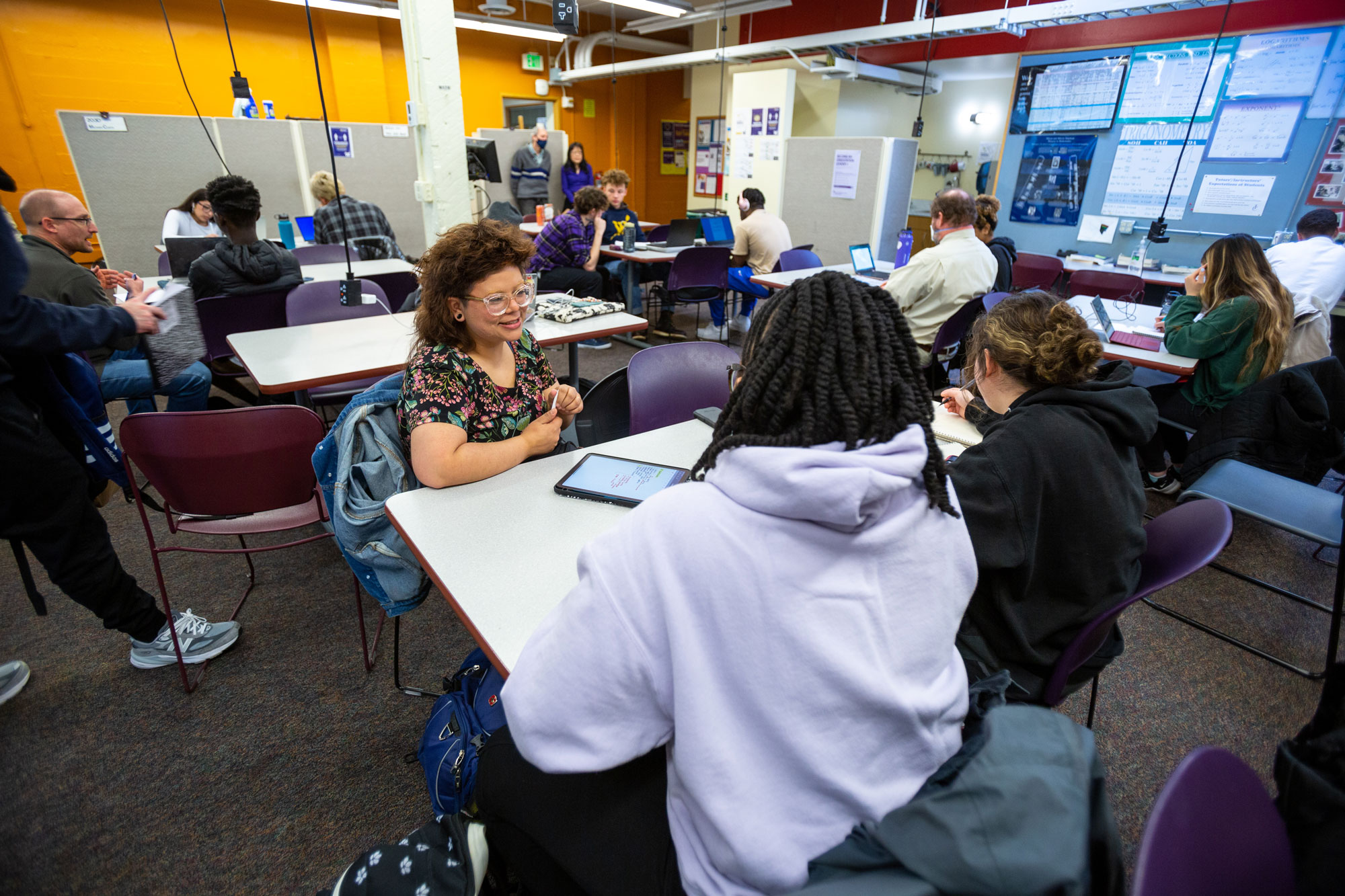
A source of support A source of support A source of support
The Instructional Center helps more than 2,000 students a year. More could use its resources.
By Shamaar Thomas | Photos by Matt Hagen | Viewpoint Magazine
Michael Sanchez needed help with physics. A first-year student who arrived at the UW in the fall of 2018 with running-start credits from Bellevue College, he took pride in excelling on his own. But “I was overwhelmed,” he says. “It was just such a big class, and they packed a lot of stuff into a relatively short period of time.”
Sanchez didn’t think he should need the extra help. But sitting in a classroom with several hundred students, next to different people every day, he grew more and more anxious. He wondered if he belonged at the UW at all.
Then, one afternoon, Sanchez walked up the concrete ramp of a former industrial building on the west side of campus. He stepped into a warm and well-worn entryway that led to a large room packed with tables and chairs and buzzing with students working diligently on hard science problems.
He noticed the instructors who were strolling around the room and dropping down into chairs to help someone through a tough question or assignment. Many of them had master’s degrees and doctorates in their fields. He also found student tutors who had recently navigated the same difficult classes he was now facing. Over the next few weeks, they taught him not to be daunted by the challenges he encountered in class, and not to be embarrassed to ask for help.
“I found such a great learning environment,” Sanchez says. “I know that’s a bit of a cliche, but as far as instructors who care and who really want to walk you step by step through material, I have found no equal.”
“Students who use the Instructional Center are 36% more likely to graduate than those who don’t. With that in mind, the University is looking to scale up the number the center serves from more than 2,000 a year to 7,000.”
Making his way into the crowded study room several nights a week, he went from dreading physics to loving it. Thanks to the resources he found at the IC, he decided to major in biophysics—one of the most notoriously difficult fields of undergraduate study. Sanchez plans to graduate in June, and like many students who have used the IC and its earlier iterations over the decades, he has set his sights on graduate school.
The Instructional Center—which serves first-generation, low-income and underrepresented minority students and students formerly in foster care—owes its existence to the student activism of the 1960s. On a list of demands presented to UW President Charles Odegaard in spring 1968, the Black Student Union-led activists cited the need and demanded funding for academic support in the form of tutoring. In the immediate wake of a season of protests, the administration set up a tutoring center and reading study skills center specifically for the students in the Educational Opportunity Program. EOP is an Office of Minority Affairs & Diversity program to provide students from underrepresented communities with recruitment, financial and social support along with services that include tutoring and instruction.
By 1971, the new Office of Minority Affairs had hired two discipline-specific instructors to teach. That quickly evolved to include more instructors and drop-in opportunities, making it even easier for students to get help when they needed it. It was the first such student support center on campus and one of the first designed to serve underrepresented minority and first-generation students in the country.
Energy and optimism have served Therese Mar, ’88, ’91, ’98, in her nine years as director and 11 years as instructor at the Instructional Center. She describes her team, many of whom have worked at the center for years, as a dedicated group of experts in their fields. They are deeply invested in promoting academic success and nurturing a community of learners, she says.
Today about 2,000 students regularly use the IC. Often, they come from backgrounds where they may not have had access to the teaching or the academic preparation that would help them thrive in certain college courses, Mar says. The IC bridges that gap by helping them develop study skills, resilience and confidence. “This is a place where we prepare them to be academically successful and increase their chances of getting admitted to their desired majors and graduate,” Mar says. “For our students, the IC is more than just a place to get academic support. It is a safe and affirming place to learn and engage with peers and teachers. It is a community.”

Therese Mar, ’88, ’91, ’98, has a bachelor’s degree in mathematics, a master’s in applied mathematics and a Ph.D. in occupational and environmental health sciences. In her 20 years at the Instructional Center and the last nine as director, she has helped students turn their B’s into A’s and guided others through their most difficult courses and on to graduate school. She can solve all kinds of problems. One she is still working on: the IC’s struggle for resources including room for studying.
The center provides drop-in tutoring for over 200 courses in biological sciences, chemistry, math, statistics, computer science, economics, accounting, physics, engineering, psychology and social sciences. And it helps with writing for any class as well as academic workshops and review sessions for math, physics, biology and chemistry—gateway classes for many of the STEM fields.
Based on data collected over years, the EOP students who use the IC are 36% more likely to graduate. With that in mind, the University is looking to scale up the number of students the center serves from more than 2,000 to 7,000, with hopes of raising $25 million in private donations to meet their instructional and tutoring needs.
Emile Pitre, who has a UW master’s degree in chemistry, has pushed for those things since he started as an IC instructor in 1978. Then, he was translating his own techniques for mastering chemistry into useful tools for students. In 1989, he became director of the center, a position he held for 13 years. He watched funding for the IC grow and diminish over the decades. And he still worries about students who might be discouraged if they can’t easily get help with their classes or have to stand in line to attend a workshop or an exam prep—a regular scene at the IC. “Lack of space and shortage of staffing” have always been his two biggest concerns for the center, he says.
Most of the IC’s work is done in a building with only two classrooms and two restrooms. The aging structure is difficult to maintain and has recurring issues with heating, ventilation, power and plumbing. “Our students are our priority,” says Mar. “They need more spaces for workshops, and spaces for tutoring and studying.”
Rainier Fox, who goes by the pronouns they and them, discovered they needed all those things when they first walked in the IC’s doors seeking help with an economics class. As they explored the warren of rooms, they found both mentors and friends. They leaned on the IC team for help with math, a class that left them in tears almost every day. “I just wanted to get through it, to get out of there,” they say. “I was uncomfortable. But the team at the IC taught me how to be uncomfortable and grow with that.” Now Fox signs up for the next challenging course and uses the IC almost every day. And they extol the center to their classmates, urging them to at least stop by and check it out.

Rainier Fox, left, is an Instructional Center regular. Like many of the students around them, they are there every week, and sometimes every day, for instruction, tutoring and often simply moral support. Today more than 2,000 students enrolled at the UW through the Educational Opportunity Program regularly use the center. Another 4,000-plus are eligible, but the center is already stretching to meet the demand.
Pitre can cite thousands of success stories from the students he encountered at the IC. “They may have been a B-plus student, but we could take them to an A,” Pitre says. He saw the IC help many first- and second-year students through the “gatekeeper” courses that could have thrown them off the path to medical school—about 250 have gone on to earn medical degrees—or other graduate studies.
“I would not be where I am today without the IC,” says Anisa Ibrahim, ’09, ’13, who came to Seattle as a child refugee from Somalia and today is a pediatrician at Harborview Medical Center. “I have never seen a more dedicated group of educators. They not only cared about our success as students but also cared about us as individuals.”
This year’s Odegaard Awardee, Norma Zavala, ’80, ’02, ’07, credits the academic support she found at the IC with helping her graduate, and the diversity of the students she met there as influencing her decision to focus on cultural relevancy and different ways of learning as a doctoral student, teacher and principal. “I come from a town that is brown and white,” she says. “And at the Instructional Center and the ECC, I’m surrounded by students of all ethnicities: Asian, Black, Latino, white and Native American. I’m learning with them and about them. … That has contributed to my advocacy for children, for education and for my wanting to learn more about diversity.”
Because the center had done so much for him, Sanchez, now a senior, decided to become a student tutor. He was surprised and delighted with the human connection within the center that he didn’t find in his STEM classes. Now he works alongside the very teachers and tutors who helped him to begin with. He emulates their way of teaching, an approach that helped him build his confidence in his hard science studies.
“Being a tutor at the IC helped me realize that we’re all just sort of making our own way and we all need help sometimes,” he says. “To be able to provide that to other people has really made me feel like part of the UW community,” he says. “One thing is scraping by. It is another to flourish in your major because of resources like the IC.”